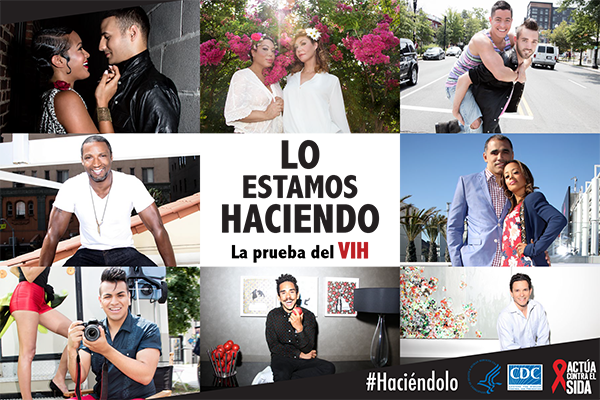
Share On Social!
Just weeks after President Donald Trump unveiled a plan to end the HIV epidemic by 2030, a CDC report showed a rising trend in HIV cases among Latinos.
Overall, the U.S. HIV rate declined by 6% from 2010-2016, according to the CDC.
But the Latino HIV rate rose 14% over the same span.
The disparity is even more stark among Latino gay and bisexual men, who suffered a 30% rise in HIV cases. The rate actually fell 16% among white gay and bisexual men.
“This CDC report shows an alarming trend that is urgent to address,” said Guillermo Chacon, of the Latino Commission on AIDS, in an email. “The messenger matters and in this case customized prevention strategies by population matters even more. It is critical to re-set and review the prevention and engagement efforts to reverse this alarming data of HIV infections among Black and Latino gay and bisexual men in our communities.”
The Bad News for Latinos
Although Latinos make up 18% of the population, they account for nearly 23% (252,400) of the estimated 1.1 million people with HIV in the United States.
 Each year, 40,000 people receive a new diagnosis of HIV.
Each year, 40,000 people receive a new diagnosis of HIV.
From 2010 to 2016, HIV diagnoses remained stable among all Latinos, while they declined among whites and blacks, according to the CDC report.
The Latino HIV rate was 4.2 times the rate for whites. The rate for Latino men was 8.6 times the rate for Latina women.
There has been 30% HIV increase among Latino gay and bisexual men, and a 68% increase among those ages 25-34. Also, 85% of Latino-diagnosed HIV infections stemmed from male-to-male sexual contact.

CDC’s report also showed that of the new infections, around 20,000 were recorded in the southern U.S.
These data suggest the gaps remain particularly troublesome in rural areas and in the South and among disproportionately affected populations like African-Americans and Latinos.
Trump’s Plans to End the HIV Epidemic
President Donald Trump vowed to end the HIV epidemic in the United States by 2030 at his State of The Union (SOTU) address on Feb. 5, 2019.
The Trump administration says its plan is to focus resources to stop the transmission of HIV on key areas of the country where HIV is prevalent.
CDC Director Dr. Robert R. Redfield said President Trump’s plan “will deploy the people and key prevention and treatment strategies needed to reduce new HIV infections by 75% over the next 5 years, with the hope of a 90% reduction within 10 years.”
President Trump’s message is step in the right direction. But a confounding one, too.
“President Trump’s pledge to end the HIV epidemic within 10 years is encouraging, but it is difficult to reconcile this statement with his administration’s systematic assault on the HIV community — including undermining access to affordable health insurance and HIV drugs; cutting funds for HIV research; and attacking LGBTQ+ people,” New York City Health Commissioner Dr. Oxiris Barbot said in a statement, CNN reports.
Barriers to Reducing HIV/AIDS
Barriers to ending AIDS have long been a lack of investment in outreach and access. Disenfranchisement from the medical system also is a factor. Language and insurance are barriers for Latinos.
Also, many people who have HIV don’t know they have it.
New study data reveal that in 2016, about 80% percent of new HIV infections were transmitted from the nearly 40 percent of people with HIV who either did not know they had HIV, or who received a diagnosis but were not being treated, according to another new CDC report in March 2019, WebMD reports.
“This is why it’s vital to bring testing and treatment to everyone with HIV — and to empower them to take control of their lives and change the course of the epidemic,” Dr. Jonathan Mermin said in a CDC news release.
Efforts to Help Eliminate HIV among Latinos
CDC supports several initiatives for culturally relevant HIV care and prevention.
For example, in 2017, CDC awarded $54 million over five years to 30 community-based organizations. These groups provide comprehensive HIV prevention services to young gay and bisexual men of color and young transgender people of color and their partners.
 CDC also have awareness and prevention campaigns:
CDC also have awareness and prevention campaigns:
- Let’s Stop HIV Together (Detengamos Juntos el VIH), which raises awareness about how HIV affects every corner of American society and fights stigma by giving a voice to people living with HIV as well as their friends and family.
- Doing It (Lo Estoy Haciendo), which encourages all adults to be tested for HIV
- Start Talking. Stop HIV. (Inicia la conversación. Detén el VIH.), which encourages open communication between gay and bisexual male sex partners and friends about HIV prevention strategies
- HIV Treatment Works (El tratamiento del VIH Es Efectivo), which encourages people with HIV to get in care and stay on treatment so they may stay healthy, protect others, and live longer, healthier lives.
“To accelerate progress, persons with HIV infection must receive a diagnosis soon after infection, begin treatment rapidly after diagnosis, adhere to treatment, and receive support services that help achieve and sustain viral suppression,” CDC authors wrote, according to HealthDay.
Explore More:
Healthcare AccessBy The Numbers
142
Percent
Expected rise in Latino cancer cases in coming years



